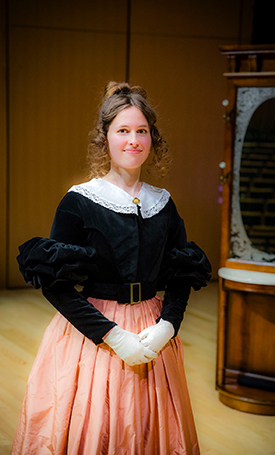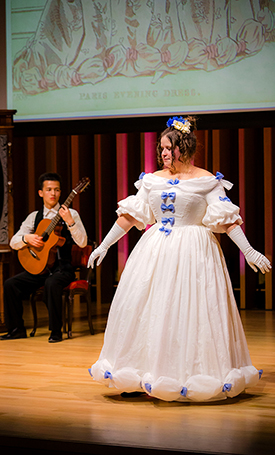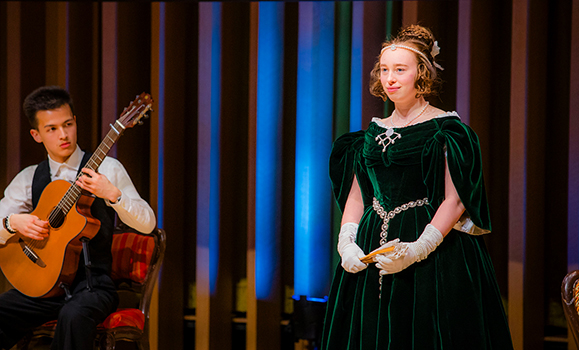Graduating students from Dalhousie's Costume Studies program transported guests back to Victorian England last Tuesday during 1837: A Presentation of Historical Dress.
Petticoats and corsets of stark white were draped across chairs and tables on stage as guests entered Dal’s Joseph Strug Concert Hall, setting the stage for an unforgettable night of Victorian fashion.
A hush fell across the crowd against a backdrop of classical music as Dr. Perin Westerhof Nyman, an assistant professor of Costume Studies at Dal, took the stage. Nearby, students delicately padded toward the traditional undergarments they’d designed with the air of sophisticated ladies of Queen Victoria’s court.
“This is the culmination of so much of what they learn in the program, certainly in my class, but also in all the other classes,” said Dr. Westerhof Nyman in an interview. She oversaw the historiclal dress project this year.
“I'm there to guide them and help them along, but so much of this is their project management. It's their choice of gown, it's their idea, and their project plan,” she says. “It's such a massive undertaking for them, and often the biggest project that they've ever taken on at this point in their careers.”
.jpg.lt_c271f1884e6dc9157e92e4bd2471a9d5.res/019HistDressAPR2024%20(1).jpg)
Students showcase their creations inspired by the dawn of the era of Queen Elizabeth's reign.
From ballgowns to day dresses
The audience was treated to a thorough exploration of a Victorian woman’s mode of dress from chemise and corsets to under-petticoats, over-petticoats, bustles, and more. The crowd listened intently to a historical account of the dressing process, laughing at anecdotes about over-starched petticoats, as one remained upright on stage with no help from students.
And then the main event.
Musician Jeremie Boudreau set the mood with classical guitar music as students Julia Beke, Sarah Cooper, Alex McCaw, Julia Sommerville, Louisa Steigenberger, Emma Wells, Sally Wilkie, and Madlyn Woodruff stepped onto the stage wearing their final designs.
 Stunning ballgowns, a riding habit, a velvet spencer, a walking gown, and day dresses took the stage in bottle green wool broadcloth, brown silk satin, black cotton velvet, blue and white hand-block-printed organdie from India, and other remarkable textiles.
Stunning ballgowns, a riding habit, a velvet spencer, a walking gown, and day dresses took the stage in bottle green wool broadcloth, brown silk satin, black cotton velvet, blue and white hand-block-printed organdie from India, and other remarkable textiles.
Alex McCaw’s handmade silk roses created using period methods wowed the audience, with each rose taking over an hour to assemble.
“I wanted to do something quite different this year. And I have a range of criteria for choosing. It has to teach certain skills to the students,” Dr. Westerhof Nyman remarked. “I also look for years that have really interesting fashions, that forced them to look into a new aesthetic. 1837 fits that bill. It was a really interesting year in terms of the technology that was being invented and developed at the time, and how things were changing politically and socially, as well.”
An 18-year-old Queen Victoria also took the British throne that year, marking the beginning of a new period and a drastic shift in women’s fashion. Dresses became longer, shoulders broader, sleeves snugger to the arm, and hoop skirts and bustles were introduced to further accentuate the hourglass figure. All these elements were highlighted during last week’s event, as the graduating students revealed their final projects.


Tapping into Victorian culture
Students selected their projects based on a wide range of research. Each student was tasked with creating the supporting garments for their design. At the end of the first term, they each submitted a proposal for their projects. From there students researched construction and began crafting their pieces throughout the second term.
.jpg.lt_d920acb358ac93fcfedd6ec8e8ac7084.res/037HistDressAPR2024%20(1).jpg)
.jpg.lt_f555171eca05106020b49fca4413bb5e.res/026HistDressAPR2024%20(1).jpg)
“Ultimately, when they hand in the final garments, they hand in all of their compiled research about every aspect of the gown’s construction, how they constructed it, and why they chose to do it that way based on original evidence,” explained Dr. Westerhof Nyman.
Students took inspiration from the Victoria & Albert Museum, China plate patterns popular during the time, portraits of Princesses Marianne van Oranje-Nasseu and Clémentine of Orléans, fashion plates from The Ladies Pocket Magazine, and other periodicals.
Using period materials
Dr. Westerhof Nyman gave students the option for fabric type, color, and print, but offered direction.
“Fabrics behave in different ways, particularly cellulose fibers like cottons and linens behave very differently from protein fibers which are your silks and wools. I really encourage them to make as much as possible in the types of fabric that would originally have been used. And substitutions can be made, you know, like a rayon velvet for a silk velvet.”
This was the case with Julia Sommerville’s recreated evening gown of deep green velvet. The heavy garment required a corset, two bustle pads, and three petticoats to support the weight of the winter garment.

The evening presentation concluded with the students expertly dancing the quadrille, a dance fashionable in Europe during the 19th century.
“These students took on so much extra with hand stitching, beading and embellishment, the fabric roses, and those things that might not be as obvious, like the piping or the hand draping, or the hand finishing that looks invisible,” Dr. Westerhof Nyman expressed. “I was just so impressed with what they took on. They did amazing work. I'm really proud of them.”

